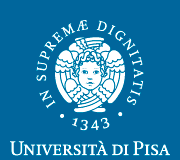
Contatti: mattia.cesauri@phd.unipi.it
Supervisori tesi: Prof. Alberto Elmi, Dott.sa Diana Fanelli (co-supervisor)
Titolo Progetto: Studio fisiologico comparato della distribuzione, espressione e attività dei sistemi melatoninergico e kisspeptinergico a livello testicolare in diverse specie di interesse veterinario, e correlazione con la funzionalità del testicolo in diverse fasi riproduttive e qualità spermatica.
Abstract: La kisspeptina e la melatonina sono due neuropeptidi principalmente prodotti a livello del sistema nervoso centrale. In particolare, la kisspeptina è codificata dal gene Kiss1, conservato in tutti i vertebrati, e la sua sintesi è stata inizialmente identificata nei neuroni “Kiss” localizzati nella regione ipotalamica. La melatonina, invece, è secreta prevalentemente dalla ghiandola pineale in risposta al ciclo luce/buio lungo l’arco dell’anno, con un picco di rilascio nelle ore di oscurità. Numerosi studi scientifici hanno indagato il ruolo di queste molecole nella regolazione dell’asse ipotalamo-ipofisi-gonadi, in particolare nella modulazione della secrezione dell’ormone di rilascio delle gonadotropine (GnRH). Più recentemente, è stato dimostrato che kisspeptina e melatonina sono anche sintetizzate e attive nei tessuti periferici, suggerendo che la regolazione della funzione riproduttiva non sia limitata al sistema nervoso centrale, ma coinvolga anche meccanismi locali a livello gonadico. La sintesi testicolare della melatonina e della kisspeptina è stata scoperta in diverse specie animali (ratto, suino, ariete, capriolo). Tuttavia, i meccanismi regolatori a livello testicolare non sono ancora stati individuati con precisione, pertanto. Nuove ricerche sono necessarie per comprendere il ruolo fisiologico ed il meccanismo d’azione della kisspeptina e della melatonia a livello testicolare, comprendendo le specie animali che presentano stagionalità riproduttiva. Nuove scoperte porterebbero possibili nuove applicazioni nella riproduzione sia in ambito veterinario che in medicina traslazionale.
Il presente studio di dottorato ha come obbiettivo quello di studiare i sistemi kisspeptinergico e melatoninergico in differenti specie animali di interesse veterinario (bovino, equino, ovicaprino e capriolo) attraverso la quantificazione dell’espressione genica e proteica della kisspeptina, melatonina e dei corrispettivi recettori a livello testicolare, durante differenti periodi della stagione riproduttiva. Il progetto di dottorato ha, inoltre, come obbiettivo l’analisi della distribuzione e localizzazione della kisspeptina, melatonina e dei loro recettori nei tessuti testicolari ed epididimali in diverse specie animali duranti i differenti periodi riproduttivi. Infine come ultimo scopo, l’osservazione dell’ espressione e distribuzione dei recettori per la melatonina e kisspeptina negli spermatozoi epididimali, durante differenti periodi riproduttivi in diverse specie animali, associate alla valutazione delle caratteristiche morfo-funzionali del seme.
Project title: Comparative physiological study of the distribution, expression and activity of the melatoninergic and kisspeptinergic systems at testicular level in different species of veterinary interest, and correlation with testis function and spermatic quality
Abstract: Kisspeptin and melatonin are two neuropeptides mainly produced in the central nervous system. Kisspeptin is encoded by the Kiss1 gene, which is present in all vertebrates. Its synthesis was first discovered in Kiss neurons within the hypothalamic region. Melatonin is predominantly produced by the pineal gland in response to the light/dark cycle throughout the year, and its release occurs during periods of darkness. Regarding their physiological role in animal reproduction, scientific research has primarily focused on their regulatory function in the secretion and modulation of gonadotropin-releasing hormone (GnRH) and the hypothalamic–pituitary–gonadal (HPG) axis. More recent studies have highlighted both the synthesis and action of these molecules in peripheral tissues. These findings demonstrate that the physiological control of animal reproduction does not occur exclusively at the level of the central nervous system but also involves peripheral regulatory systems within the gonads.Testicular synthesis of melatonin and kisspeptin has been identified in various animal species (rat, pig, ram, roe deer). However, the regulatory mechanisms at the testicular level have not yet been fully elucidated. Therefore, further research is required to better understand the physiological role and mechanisms of action of kisspeptin and melatonin within the testis, especially in animal species exhibiting seasonal reproductive patterns. Such discoveries may open new avenues for applications in both veterinary reproduction and translational medicine.
The aim of the present PhD study is to investigate the kisspeptinergic and melatonergic systems in different animal species of veterinary interest (bovine, equine, ovine-caprine, and roe deer), by quantifying gene and protein expression levels of kisspeptin, melatonin, and their respective receptors at the testicular level during different stages of the reproductive season. The study will also examine the distribution and localization of kisspeptin, melatonin, and their receptors in testicular and epididymal tissues across reproductive periods in different animal species. Furthermore, the expression and distribution of melatonin and kisspeptin receptors inepididymal spermatozoa will be evaluated during different reproductive phases, in association with the assessment of semen morpho-functional parameters.
SCOPUS: https://www.scopus.com/authid/detail.uri?authorId=59458660500
ORCID: https://orcid.org/0009-0002-2304-6231
Pubblicazioni:
- P. Banchi, F. Solanes-Vilanova, M. Cesauri, L. Spanoghe, K. Chiers, A. Van Soom, T. Hellebuyck, G. Rizzoto. Sperm cryopreservation and reproductive characteristics in the beauty snake (Elaphe taeniura) as a model for endangered Colubridae. Cryobiology 118 (2025) 105184. doi: 10.1016/j.cryobiol.2024.105184
Comunicazioni orali a congresso:
- M. Cesauri, D. Ventrella, I. Troisio, N. Govoni, M. L. Bacci, A. Elmi. Hair steroid quantification: a non-invasive method to asses reproductive and welfare in wild and laboratory species. Measurments and Applications in Veterinary and Animal Sciences (MeAVeAS 2025), Pisa, Italy, April 2025.
- F. Solanes Vilanova, P. Banchi, G. Rizzoto, M. Cesauri, L. Spanoghe, A. Van Soom, T. Hellebuyck. Sperm cryopreservation in the Taiwanese rat snake (Elaphe taenuria) as a model for endangered Colubridae. Avian, Herpetological, Exotic Mammal, Zoo and Wildlife Medicine (ICARE 2024), 6th International Conference, Gent, Belgium.
Poster a congresso:
- S. Mecocci, M. Cesauri, A. Giontella, K. Cappelli, M. Silvestrelli, A. Verini Supplizi, S.Capomaccio. Allelic frequencies of Warmblood Fragile Foal Syndrome (WFFS) gene mutation in the Italian horse population. 25th congress Animal Production Science: innovation and sustainability for future generations (ASPA 2023), Monopoli, Bari, Italy
Premi:
- Best Poster at 25th congress Animal Production Science: innovation and sustainability for future generations (ASPA2023), Monopoli, Bari, Italy.
